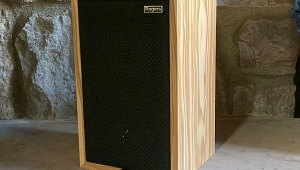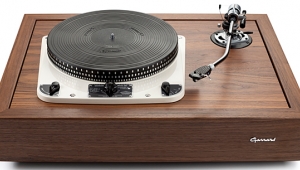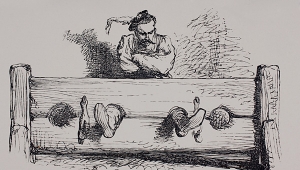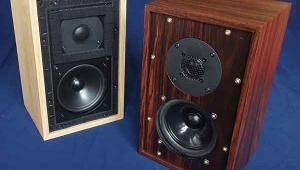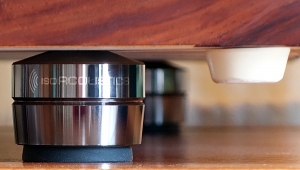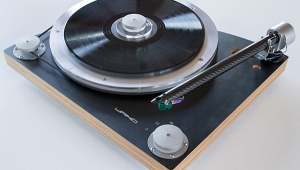| Columns Retired Columns & Blogs |
Listening #58 Auditorium 23 Hommage, August 2009
Art Dudley returned to the Auditorium 23 Hommage in August 2009 (Vol.32 No.8):
Footnote 1: DB Systems, PO Box 460, 214 Main Street, Rindge, NH 03461. Tel: (603) 899-5121. Web: www.dbsystemsaudio.com.
This whole thing started up again when I tried to improve the phono-input section of my main system—not to enhance its performance (although you might expect that to happen), but to provide a fairer, more flexible context for evaluating new cartridges.
The technical reason: Taken in isolation, even the small collection of phono cartridges that I own—Miyabi 47, Rega Elys, Grace F9E, Denon DL-103, and EMT OFD 25—represent a pretty wide range of resistive-loading requirements. The low-impedance Miyabi 47 and the high-impedance Denon DL-103, for example, couldn't be more different from one another, despite their similar outputs.
Now: Having cast aside most of the cartridge-alignment tools I've bought over the years—the Cart-A-Lign, the Geodisc, the Dennessen Soundtraktor, various incarnations of the WallyTractor—in favor of the elegant, accurate, and easy-to-use DBP-10 alignment protractor, my phono-accessory thoughts turned once again to that product's manufacturer, DB Systems (footnote 1). So in February I ordered their DBP-6MC Resistive Loading Kit, an ancient but eminently serviceable thing to have, and very affordable at $49.
The DBP-6MC kit is based around a pair of flexible Y-adapters, each having two phono sockets at one end and a single phono plug at the other. The idea, of course, is to plug the Y-adapters into the phono inputs of your preamp or integrated amp, then to plug your left- and right-channel tonearm leads into one leg each of the two phono-socket pairs. The remaining sockets can then be loaded with your choice of resistive plugs (also included), to provide a specific value in parallel with your phono cartridge. The DBP-6MC comes with five pairs of color-coded resistive plugs: 10, 20, 50, 100, and 200 ohms. Using any of those values in parallel with 47k ohms will greatly decrease phono input impedance overall, allowing the cartridge's "motor" to electromechanically damp itself. The DBP-6MC also includes an "empty" pair of plugs, into which you can solder the alternate resistor values of your choice.
I pause here to confess the selfish sub-motive lurking beneath all the self-congratulatory twaddle about "fairness" and "flexibility." My reference preamplifier, the damn good Shindo Masseto, has two pairs of phono inputs: one for moving-magnet cartridges, the other for moving-coil, the latter providing additional gain and appropriate loading with a pair of custom-wound Lundahl transformers. (I don't know the specs of those transformers, but because they were said to be designed around the low-output Ortofon SPU series of pickup heads, it's a safe guess that their primary coils are of low impedance and their impedance ratio is high.) As I mentioned above, I also own an EMT OFD 25 mono pickup head: a wonderful-sounding MC device, but with gain so high that, when I use it to drive the Shindo's MC inputs, I'm forced to turn down the volume controls on my Shindo monoblock amps just to keep the resulting loudness from blowing my scalp free of the rest of my head, Mr. Weatherbee style.
Yet while the gain provided by the Masseto's MM inputs would seem ideal for use with the OFD 25's high output, the 47k ohm load impedance wouldn't. Indeed, EMT's distributor recommends for the OFD 25 a load between 100 and 300 ohms.
Thus I reasoned: What could be better than to use the 100 or 200 ohm plugs of the DBP-6MC, alongside the EMT pickup head, into my Shindo Masseto's MM inputs? That would surely sound heavenly.
I began by revisiting the EMT OFD 25 straight into the 47k ohm inputs, with the DB Systems Y-adapters in-line but without extra resistors in place: That experience refreshed my memory of how tonally off-kilter the sound was the last time I tried it. After that, inserting DB Systems' various resistive plugs was a simple enough matter—doable even with the volume turned up.
But the 200 ohm resistors only made my records sound deader and duller, stripped of musical life and sonic presence alike. So did the 100, 50, 20, and 10 ohm plugs, to even greater degrees.
In every sense, used in parallel with every loading resistor at my disposal, the MM inputs on my Shindo Masseto didn't sound good with this high-output pickup head: I appeared to be stuck using the much-better-sounding MC inputs for the rest of my life—oh, the drudgery—and having to compensate by turning down the volume whenever I wanted to hear my mono records.
Or so it seemed. The only combination of in-house components I had never tried—and which I knew would not work—was to substitute Auditorium 23's even higher-gain Hommage T1 step-up transformer ($4695) for the Masseto's built-in transformers, for use with the OFD 25.
I first wrote about the Hommage T1 in my October 2007 "Listening" column. Created by the German design and distribution house Auditorium 23 (footnote 2), the T1 was intended as the first of a separate line of statement products that pay homage to the classics of audio's golden era. (The Hommage T1 was preceded by the markedly more affordable, $975 Auditorium 23 Standard step-up transformer, which I also covered in the October 2007 issue.) Indeed, Auditorium 23's Keith Aschenbrenner, whose personal collection of vintage gear is said to be considerable, destroyed a few of his most prized transformers in an effort to discover their secrets, and to reproduce them in the Hommage T1.
Among those sacrificed was a product that some enthusiasts regard as the holy grail of all step-up transformers: the Western Electric 618B. Designed and sold as a transformer for WE's own microphones, the 618B's frequency range of 30Hz–15kHz suited it to phono use, as did its 30 ohm primary and approximately 833:1 impedance ratio (for a gain factor of about 29).
Aschenbrenner's Hommage T1 measures somewhat differently, with a primary coil impedance of about 3 ohms and a secondary coil impedance of 2.8k ohms. That's an impedance ratio of 933:1, which works out to a turns ratio/gain factor of approximately 30. The gain in decibels (20 times the base-10 logarithm of 30) is about 29dB. That's a lot—and is, again, one of the reasons I never bothered trying it with the 5mV-output OFD 25.
Until today. Turns out I was a fool for having two such astounding products in my home and never trying them together: great potential that died of a theory. To listen to EMT's classic OFD 25 pickup head playing through the Hommage T1 transformer is to wish, actively and strenuously, that literally every record in my collection was monophonic. The musical and emotional impact I enjoyed with this pairing far exceeded the sonic thrills of even the finest, most convincing spatial effects available from a stereo recording (by a ratio of about 30:1, I'm tempted to say).
What could account for such performance? Hard to say—the Hommage T1 is sealed inside an unopenable box. (I'm told by the importer that, if absolutely necessary, the wooden end pieces can be removed, but that requires a hammer, and the pieces tend to come off in splinters.) As an importer of Shindo Laboratory gear who has had to put up with single-ended-triode nerds who reverse-engineered the circuits of his products and published them on the Internet, Keith Aschenbrenner can be forgiven his secrecy, I think.
For whatever reason, and beyond all expectations, this decidedly high-gain, low-primary-impedance transformer has now teased the best performance out of literally every MC cartridge I have. Even a Shindo SPU sounds better through the Hommage T1 than through the custom-wound transformer in Shindo's own Masseto preamp: richer, more colorful, and, above all, more tactile—more exciting. But the pinnacle remains that least likely pairing, with the EMT OFD 25 monophonic pickup head: Listening to a good, chunky, honest, unphasey, simply made mono record through that combination consistently helped me distance myself from the reality of the mundane by bringing me closer to the reality of music.
Which is why I have no choice but to buy it. Until something better comes along, whenever listening for pleasure is the order of the day, the Hommage T1 is the product I'll use.—Art Dudley
Footnote 1: DB Systems, PO Box 460, 214 Main Street, Rindge, NH 03461. Tel: (603) 899-5121. Web: www.dbsystemsaudio.com.
Footnote 2: Auditorium 23, Gabelsbergerstrass 23, D-60389 Frankfurt, Germany. Tel: (49) (0)69-4652202. Web: www.auditorium23.de. US distributor: Tone Imports LLC. Tel: (646) 425-7800. Web: www.toneimports.com.
- Log in or register to post comments


